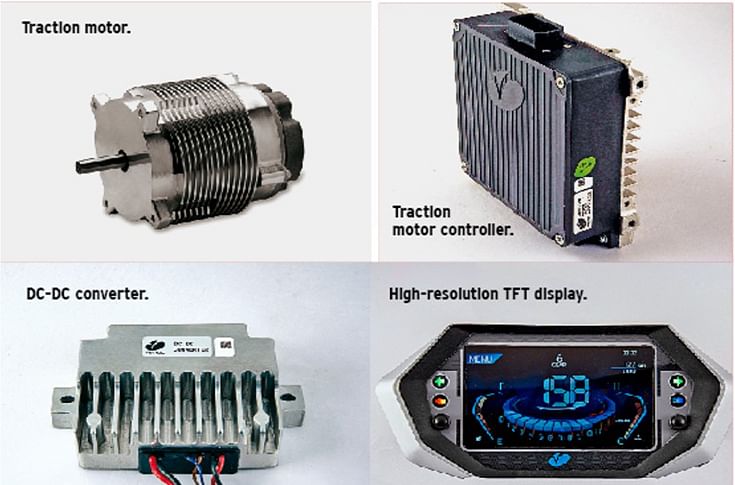The great electric rush
While the Indian two-wheeler industry is making adroit moves to transition into electric mobility, OEMs and suppliers say the quick way to improve EV adoption is to offer a fundamentally good product.
The two-wheeler industry is no doubt seeing select green shoots but a complete revival will also depend on how the sector looks at expanding and creating additional demand. India is targeting an ambitious 30 percent of overall vehicle sales to be EVs by 2030. The current trend clearly indicates that the two-wheeler and last mile-three-wheeler delivery segments to be amongst the early adopters.
Data from FY2020 shows that overall electric two-wheeler sales were over 150,000 units and accounted for nearly 97 percent of the total EV sales. Though the share of electric cars has increased in the past two years, electric two-wheelers still lead the race, thanks to being more affordable than electric cars.
However, the pace and the pattern of consumer trends are changing as awareness about EVs is increasing rapidly across the country. This is exactly why on day two of Autocar Professional’s Two-Wheeler Week, the overall theme of was ‘Race To Go Electric’. The power-packed panel of speakers included:
-Ravneet Phokela, Chief Business Officer, Ather Energy
-Arjun Jain, Business Head — Electrical / Electronic at Varroc Group
-Kabir Bhandari, Padmini VNA Mechatronics
-Shivalik Prasad, VP (Sales & Alliances), Sibros
Ravneet Phokela, Chief Business Officer at Ather Energy, kicked off the discussion with his observations about the pattern of EV transition in India and impact of the push from both the Central and State governments. “No one wants to pay a penny to save the world if the product does not make sense and add value for the customer.

The panellists were of the consensus that a sharp focus on optimising and value engineering will power the race towards faster EV adoption in the two-wheeler market.
What’s encouraging is that the quality of consumer awareness about EVs has gone through a significant shift. The willingness to buy and adopt changes dramatically as the EV starts being seen as an upgrade to a better solution. So, the tailwinds are really strong. And, these are happening much faster than what we imagined,” said Phokela.
Phokela added that the fundamental aspect for an EV to succeed is that the product needs to make market sense. If it is similar to an ICE two-wheeler, the customer may look at choosing it. “Building a good scooter is a must and then comes the features. That is why Ather concentrated on building a fundamentally good scooter first before adding touch-screens, remote diagnostics et al. Features are peripheral and no amount of TCO can give a push to a fundamentally bad product. Also, the technology can be a differentiator, but eventually it will behave how the automotive behaves,” explained Phokela.
Shivalik Prasad, Vice-President (Sales & Alliances), Sibros, which is an automotive software and cloud company enabling the connected vehicle ecosystem, said that the EV revolution is already happening in India. Citing the example of e-rickshaws in north India, he added that EVs have also entered rural markets. “There are many new operators in the market but ultimately it will be a good product that will determine the final outcome. Electrification is being adopted in a big way in rural India, especially given the access to free electricity,” he said.

Having made strategic moves as long as five years ago to tap the electrification megatrend, global Tier 1 supplier Varroc is ready with its indigenously developed suite of products for EVs.
Lowering the total cost of ownership
Cost plays a major role in convincing buyers to opt for an EV. Market studies indicate that many who want to buy an electric two-wheeler stay away from it mainly because of the high initial costt. So, how is the industry planning to tackle it? Arjun Jain, Business Head — Electrical/Electronics at Varroc Group said, “Localisation is imperative without which you cannot have the right cost structure. At Varroc, we have localised every electric and electronic component. The high degree of localisation boosts OEMs’ confidence. At the same time, scale benefits do not make us nervous. From a supply chain perspective too, I don’t think this is too much of a challenge.”
“Also, now there is a lot of awareness. Scaling up is not a problem and the supply chain hasn’t really been caught napping. But, to have a viable EV, you have to have an efficient motor,” he pointed out.
Offering a different perspective, Kabir Bhandari, MD, Padmini VNA Mechatronics, stated that the risk is to invest more in the battery. “Fundamentally, the Indian two-wheeler market of 20 million units brings in scale. The key cost and risk factor is the battery, both in terms of safety and affordability. Also, the biggest challenge is battery production. As battery tech is evolving, investing in a battery trend and suddenly finding it obsolete would be an issue. In the motor, there is a flexibility which is not in battery manufacturing.”
He also mentioned that motors have been there for years. Efficiency was what they concentrated on and they focussed on making the power, torque and efficiency curve in their motor as wide as possible. “We were able to develop an Axial Flux Tech e-motor using conventional materials, which has given a very power dense package over a wide engine speed range. Also, we are going to be ready to manufacture with capacity that the industry needs. Huge amount of fragmentation in motors is on offer. We see a narrowing down of motor dynamics and focussing on efficiency and power density to grab a better share of the market,” he said.
Adding to what Jain and Bhandari said, Phokela said that both scale and localisation will help reduce cost. He mentioned that this new age of vehicles provides an opportunity to both suppliers and OEMs to work together right from the design aspect. With this in place, the volumes will also pick up, reducing the cost.
Sibros' Shivalik Prasad added that the supply of skilled manpower is an issue now. “We need good designers who can future- proof us. If that is in place, we should be able to cut costs and do a lot. Many are working towards it. Also, there are many new revenue streams which will pop up in the near future. It all depends on who picks it up,” he said.
But, according to Prasad, the huge opportunity for a company like Sibros and the industry lies the product itself. EV charging infrastructure and other aspects open up a whole new set of business opportunities which "are bigger than selling the vehicle. Many new systems might also come, "he pointed out.

The panellists believe that scale will help in faster EV adoption and free eectricity in rural India can boost EV usage.
Role of legislation
Speaking on the legislation aspect, Varroc’s Jain stated that there is a need to focus more on the direction where the market potential evolves. Ather’s Phokela added that legislation may shave off a few years from the time required for full EV transition, but even without that he expects the pace of EV adoption to be brisk across India.
On a personal note, the Sibros VP said, “Government may end ICE two-wheelers in some years. When things stabilise, I expect a sunset legislation to come out. I expect more features and better-connected tech and see scope for more personalisation in future. There is a possibility of the government taking more steps to accelerate EV adoption. Eventually, you can also expect legislation coming in that would look at banning two-wheelers that run on IC engines."
“Optimising and value engineering is crucial. EVs are an unstoppable trend. Legislation may impact the pace of acceleration but the wave is likely to seal the business potential,” concluded Bhandari.
It goes without saying the EV trend is unstoppable. Globally, we see companies and countries racing to implement policies that can make net carbon zero faster.
Along with companies, more than 130 countries are now actively considering a target of reducing emissions to net zero by 2050. Steep emission cuts — especially by the largest greenhouse-gas emitters — are imperative in the next 5 to 10 years in order to keep global warming to no more than 1.5 degree Centigrade.
RELATED ARTICLES
How Venkat Thimaraju Bridged Mines and Machines for Daimler
From a young engineer's vision : Daimler India unleashes next-Gen trucks for India's booming construction and mining sec...
Tata Motors: From Ice Legacy To Electric Intelligence
Tata Motors has a lot riding on the newly launched Harrier EV, coming as it does on a fresh, EV-oriented software platfo...
Complete List of Cars and SUVs Tested by Bharat NCAP
Bharat NCAP has crash-tested 20 models to date, including both ICE-powered vehicles and EVs.





 23 Nov 2021
23 Nov 2021
 4708 Views
4708 Views





 Shahkar Abidi
Shahkar Abidi


 Ketan Thakkar
Ketan Thakkar


